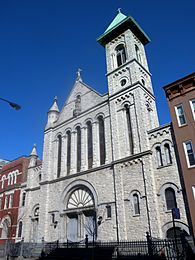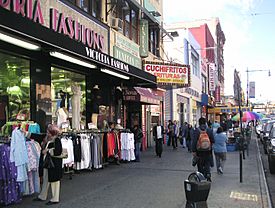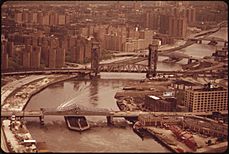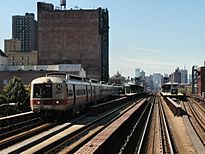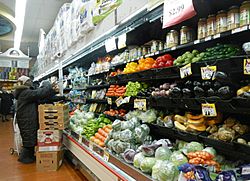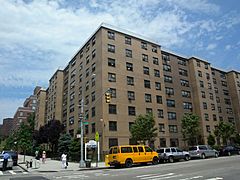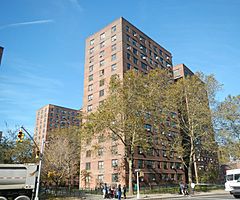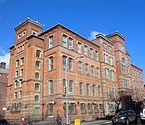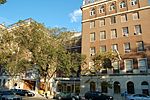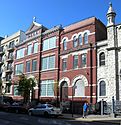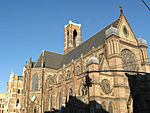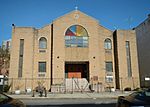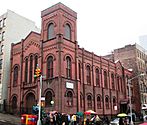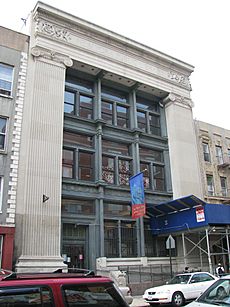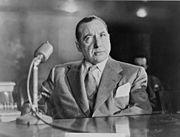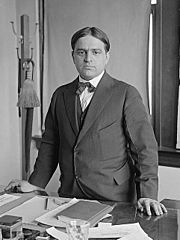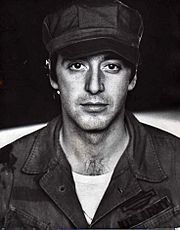East Harlem facts for kids
Quick facts for kids
East Harlem
|
|
|---|---|
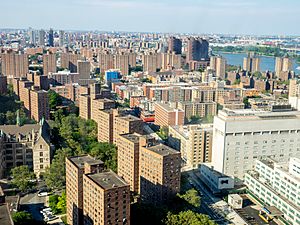
Looking north from 2nd Avenue and 96th Street (2019)
|
|
| Country | United States |
| State | |
| City | New York City |
| Borough | Manhattan |
| Community District | Manhattan 11 |
| Population
(2010)
|
|
| • Total | 115,921 |
| Ethnicity | |
| • Hispanic | 52.1% |
| • Black | 35.7% |
| • White (non-Hispanic) | 7.3% |
| • Asian | 2.7% |
| • Other | 0.2% |
| Economics | |
| • Median income | $21,480 |
| Time zone | UTC−5 (Eastern) |
| • Summer (DST) | UTC−4 (EDT) |
| ZIP Codes |
10029, 10035
|
| Area code | 212, 332, 646, and 917 |
East Harlem, also known as Spanish Harlem or El Barrio and historically known as Italian Harlem, is a neighborhood of Upper Manhattan, New York City, roughly encompassing the area north of the Upper East Side and bounded by 96th Street to the south, Fifth Avenue to the west, and the East and Harlem Rivers to the east and north. Despite its name, it is generally not considered to be a part of Harlem proper, but it is one of the neighborhoods included in Greater Harlem.
The neighborhood is one of the largest predominantly Hispanic communities in New York City, mostly made up of Puerto Ricans, as well as sizeable numbers of Dominican, Cuban and Mexican immigrants. The community is notable for its contributions to Latin freestyle and salsa music. East Harlem also includes the area formerly known as Italian Harlem, in which the remnants of a once predominantly Italian community remain. The Chinese population has increased dramatically in East Harlem since 2000.
East Harlem has historically suffered from many social issues, such as a high crime rate, the highest jobless rate in New York City, homelessness, and an asthma rate five times the national average. It has the second-highest concentration of public housing in the United States, behind Brownsville, Brooklyn. However, East Harlem is undergoing some gentrification. In February 2016, East Harlem was one of four neighborhoods featured in an article in The New York Times about "New Hot Neighborhoods", and the city was considering re-zoning the area.
East Harlem is part of Manhattan Community District 11, and its primary ZIP Codes are 10029 and 10035. It is patrolled by the 23rd and 25th Precincts of the New York City Police Department.
Contents
History
Early history
The area which became East Harlem was rural for most of the 19th century, but residential settlements northeast of Third Avenue and East 110th Street had developed by the 1860s. The construction of the elevated transit line to Harlem in 1879 and 1880, and the building of the Lexington Avenue subway in 1919, urbanized the area, precipitating the construction of apartment buildings and brownstones. The extension of cable cars up Lexington Avenue into East Harlem was stymied by the incline created by Duffy's Hill at 103rd Street, one of the steepest grades in Manhattan. East Harlem was first populated by poor German, Irish, Scandinavian, and Eastern European Jewish immigrants, with the Jewish population standing at 90,000 around 1917. In the 1870s, Italian immigrants joined the mix after a contractor building trolley tracks on First Avenue imported Italian laborers as strikebreakers. The workers' shantytown along the East River at 106th Street was the beginning of an Italian neighborhood, with 4,000 having arrived by the mid 1880s. As more immigrants arrived, it expanded north to East 115th Street and west to Third Avenue.
East Harlem now consisted of pockets of ethnically-sorted settlements – Italian, German, Irish, and Jewish – which were beginning to press up against each other, with the spaces still between them occupied by "gasworks, stockyards and tar and garbage dumps". In 1895, Union Settlement Association, one of the oldest settlement houses in New York City, began providing services in the area, offering the immigrant and low-income residents a range of community-based programs, including boys and girls clubs, a sewing school and adult education classes.
Italian Harlem
Southern Italians and Sicilians, with a moderate number of Northern Italians, soon predominated, especially in the area east of Lexington Avenue between 96th and 116th Streets and east of Madison Avenue between 116th and 125th Streets, with each street featuring people from different regions of Italy. The neighborhood became known as "Italian Harlem", the Italian American hub of Manhattan; it was the first part of Manhattan to be referred to as "Little Italy". The first Italians arrived in East Harlem in 1878, from Polla in the province of Salerno, and settled in the vicinity of 115th Street.
In the 1920s and early 1930s, Italian Harlem was represented in Congress by future Mayor Fiorello La Guardia, and later, in the 1950s and 1960s, by Italian-American civil rights lawyer, activist, and socialist Vito Marcantonio. The Italian neighborhood approached its peak in the 1930s, with over 100,000 Italian-Americans living in its crowded, run-down apartment buildings. The 1930 census showed that 81 percent of the population of Italian Harlem consisted of first- or second-generation Italian Americans. (Somewhat less than the concentration of Italian Americans in the Lower East Side’s Little Italy with 88 percent; Italian Harlem’s total population, however, was three times that of Little Italy.)
The Italian community in East Harlem remained strong into the 1980s, but it has slowly diminished since then. However, Italian inhabitants and vestiges of the old Italian neighborhood remain. The annual Feast of Our Lady of Mount Carmel and the "Dancing of the Giglio", the first Italian feast in New York City, is still celebrated there every year on the second weekend of August by the Giglio Society of East Harlem. Italian retail establishments still exist, such as Rao's restaurant, started in 1896, and the original Patsy's Pizzeria which opened in 1933. In May 2011, one of the last remaining Italian retail businesses in the neighborhood, a barbershop owned by Claudio Caponigro on 116th Street, was threatened with closure by a rent increase.
Spanish Harlem
Puerto Rican and Latin American immigration after the First World War established an enclave at the western portion of East Harlem – around 110th Street and Lexington Avenue – which became known as "Spanish Harlem". The area slowly grew to encompass all of East Harlem, including Italian Harlem, as Italians moved out – to the Bronx, Brooklyn, upstate New York and New Jersey – and Hispanics moved in during another wave of immigration in the 1940s and 1950s. Although in certain areas, particularly around Pleasant Avenue, Italian Harlem lasted through the 1970s, today most of the former Italian population is gone. Most of these predominantly older residents are clustered around Our Lady of Mount Carmel Church, mainly from 114th to 118th Streets. According to the 2000 Census, there were only 1,130 Italian-Americans still living in this area.
The newly dominant Puerto Rican population, which reached 63,000 in 1950, continued to define the neighborhood according to its needs, establishing bodegas and botánicas as it expanded; by the 1930s there was already an enclosed street market underneath the Park Avenue railroad viaduct between 111th and 116th Streets, called "La Marqueta" ("The Market"). Catholic and evangelistic Protestant churches appeared in storefronts. Although "Spanish Harlem" had been in use since at least the 1930s to describe the Hispanic enclave – along with "Italian Harlem" and "Negro Harlem" – the name began to be used to describe the entire East Harlem neighborhood by the 1950s. Later, the name "El Barrio" ("The Neighborhood") began to be used, especially by inhabitants of the area.
Decline
In the 1950s and 1960s, large sections of East Harlem were leveled for urban renewal projects, and the neighborhood was one of the hardest hit areas in the 1960s and 1970s as New York City struggled with deficits, race riots, urban flight, gang warfare, crime and poverty. Tenements were crowded, poorly maintained, and frequent targets for arson.
Recent history
By the beginning of the 21st century, East Harlem was a racially diverse neighborhood, with about a third of the population being Puerto Rican. As it has been throughout its history, it is predominantly a working-class neighborhood.
Until 2006, property values in East Harlem climbed along with those in the rest of New York City. With increased market-rate housing, including luxury condos and co-ops - most built on formerly vacant lots - there has been some decline of affordable housing in the community. A number of young professionals have settled into these recently constructed buildings. This influx of "yuppies" has caused rents to rise, more buildings in the area to get gut renovations and is changing area demographics.
Demographics
The New York City Department of City Planning classifies East Harlem into two neighborhood tabulation areas: East Harlem North and East Harlem South, divided along 115th Street. The two areas had a combined population of 115,921, an increase of 1,874 (1.4%) from the combined 114,047 in the 2000 Census.
Based on data from the 2010 United States Census, the population of East Harlem North was 58,019, an increase of 871 (1.5%) from the 57,148 counted in 2000. Covering an area of 573.94 acres (232.27 ha), the neighborhood had a population density of 101.1/acre (64,700/sq mi; 25,000/km2). The racial makeup of the neighborhood was 6.8% (3,936) White, 35.5% (20,625) African American, 0.2% (128) Native American, 3.0% (1,766) Asian, 0.0% (9) Pacific Islander, 0.3% (185) from other races, and 1.3% (769) from two or more races. Hispanic or Latino of any race were 52.7% (30,601) of the population.
Based on data from the 2010 Census, the population of East Harlem South was 57,902, an increase of 1,003 (1.8%) from the 56,899 counted in 2000. Covering an area of 389.41 acres (157.59 ha), the neighborhood had a population density of 148.7/acre (95,200/sq mi; 36,700/km2). The racial makeup of the neighborhood was 17.4% (10,072) White, 24.6% (14,227) African American, 0.2% (96) Native American, 8.3% (4,802) Asian, 0.1% (55) Pacific Islander, 0.4% (218) from other races, and 1.6% (933) from two or more races. Hispanic or Latino of any race were 47.5% (27,499) of the population.
The most significant changes in the racial composition of East Harlem between 2000 and 2010 were the Asian population's increase by 109% (3,427), the White population's increase by 68% (5,689), and the Black population's decrease by 12% (4,625). Although more of the influx of Asian and White residents was in East Harlem South, the greatest percentage growth was in East Harlem North, while the Black population's decrease was evenly split. The Hispanic/Latino population also decreased by 4% (2,485), a decrease almost entirely concentrated in East Harlem South, where it fell from being the majority group to the plurality group. The small population of other races experienced a slight increase of 5% (132).
The entirety of Manhattan Community District 11, which consists of East Harlem, Randall's Island, and Ward's Island, had 124,323 inhabitants as of NYC Health's 2018 Community Health Profile, with an average life expectancy of 77.3 years. This is 3.9 years lower than the median life expectancy of 81.2 for all New York City neighborhoods. Most residents are children and middle-aged adults: 21% are between the ages of 0–17, while 33% are between 25 and 44, and 23% are between 45 and 64. The ratio of college-aged and elderly residents was lower, at 10% and 13% respectively.
As of 2017, the median household income in Community District 11 was $36,770. In 2018, an estimated 23% of Community District 11 residents lived in poverty, compared to 14% in all of Manhattan and 20% in all of New York City. One in nine residents (11%) were unemployed, compared to 7% in Manhattan and 9% in New York City. Rent burden, or the percentage of residents who have difficulty paying their rent, is 48% in Community District 11, compared to the boroughwide and citywide rates of 45% and 51% respectively. Based on this calculation, as of 2018[update], Community District 11 is considered to be gentrifying: according to the Community Health Profile, the district was low-income in 1990 and has seen above-median rent growth up to 2010.
Ethnic groups
Community District 11 is a mostly low to middle income area. It is made up of first and second generation Puerto Ricans, African-Americans, Italian-Americans, Asian-Americans, West Indian Americans (especially Dominican Americans and Cuban Americans), and a growing population of Mexican Americans and Salvadoran Americans and other Central American immigrants. It has one of the highest concentrations of Puerto Ricans in all of New York City. As of 2010, the Puerto Rican population was 27.7% in zip code 10029, and 23.4% in 10035. 10035 also has a large Mexican population, at 10.7%.
As noted before, the number of Asians in East Harlem more than doubled between 2000 and 2010, largely due to Chinese people moving to East Harlem. Increasing rents in Lower Manhattan's Chinatown have driven many into public and subsidized housing developments in the neighborhood. Advocates have been calling for Chinese language services to be available in the community centers to accommodate the growing number of Chinese residents in the area. In 2000, the Chinese population in the northern portion was less than one percent, but by 2010, it has gone up to being three percent in the area. In the southern part, it rose from 4.6% to 8.4%.
Transportation
The Harlem River separates the Bronx and Manhattan, necessitating several spans between the two New York City boroughs. Three free bridges connect East Harlem and the Bronx: the Willis Avenue Bridge (for northbound traffic only), Third Avenue Bridge (for southbound traffic only), and Madison Avenue Bridge. In East Harlem, the Wards Island Bridge, also known as the 103rd Street Footbridge, connects Manhattan with Wards Island. The Triborough Bridge (officially the Robert F. Kennedy Bridge) is a complex of three separate bridges that offers connections between Queens, East Harlem, and the Bronx.
Public transportation service is provided by the Metropolitan Transportation Authority. The New York City Subway's IRT Lexington Avenue Line runs through East Harlem, with an express station at 125th Street (served by the 4 5 6 <6> routes) as well as local stations at the 116th Street, 110th Street, 103rd Street, and 96th Street (served by the 6 <6> routes). There is also a Second Avenue Subway station at 96th Street on the Q route. MTA Regional Bus Operations' M15, M15 SBS, M35, M60 SBS, M96, M98, M100, M101, M102, M103, M106, M116 and Bx15 bus routes serve East Harlem as well. Metro-North Railroad has a commuter rail station at Harlem–125th Street, serving trains to the Lower Hudson Valley and Connecticut.
Social issues
East Harlem has the highest concentration of shelters and facilities in Manhattan, with eight homeless shelters and 37 mental health treatment facilities. It also has the highest jobless rate in the entire city. The asthma rate is also 5 times larger than national levels. The neighborhood also suffers from a high poverty rate. Union Settlement Association is one of the neighborhood's largest social service agencies, reaching more than 13,000 people annually at 17 locations throughout East Harlem, through a range of programs, including early childhood education, youth development, senior services, job training, the arts, adult education, nutrition, counseling, a farmers' market, community development, and neighborhood cultural events.
Fresh food
A lack of access to healthy food causes serious hardships to citizens of East Harlem, a neighborhood that is considered to be a food desert. According to an April 2008 report prepared by the New York City Department of City Planning, East Harlem is an area of the city with the highest levels of diet-related diseases due to limited opportunities for citizens to purchase fresh foods.
With a high population density and a lack of nearby supermarkets, the neighborhood has little access to fresh fruit and vegetables and a low consumption of fresh foods. Citizens of East Harlem are likely to buy food from grocery stores that have a limited supply of fruits and vegetables, which are often of poor quality and generally more expensive than the same products sold at supermarkets. Compared to the Upper East Side, supermarkets in Harlem are 30% less common. Without access to affordable produce and meats, East Harlem residents have difficulty eating a healthy diet, which contributes to high rates of obesity and diabetes.
In 2011, Manhattan Borough President Scott Stringer announced a program that would send Veggie Vans to East Harlem senior centers and housing projects. In 2012, Whole Foods announced two uptown locations, one being on 125th Street and Lenox Avenue, the other in the Upper East Side. In 2010, Aldi's Grocery opened at the East River Plaza located at E. 117th St. and FDR Drive, providing access to affordable food for East Harlem's residents. In 2013, a new Super FI Emperior Grocery store opened up in East Harlem on 103rd Street and Lexington Avenue.
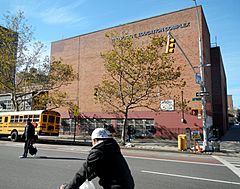

Housing
East Harlem is dominated by public housing complexes of various types, with a high concentration of older tenement buildings between these developments. The neighborhood contains the highest geographical concentration of low income public housing projects in the United States. The total land area is 1.54 square miles (4.0 km2).
After a wave of arson ravaged the low income communities of New York City throughout the 1970s, many of the residential structures in East Harlem were left seriously damaged or destroyed. By the late 1970s, the city began to rehabilitate many abandoned tenement style buildings and designate them as low income housing.
Despite recent gentrification of the neighborhood, large numbers of apartment buildings have been deliberately kept vacant by their owners. Although the businesses on the ground floor are retained, landlords do not want to have the trouble involved in residential tenants. In some cases, landlords are waiting for a revived economy, warehousing the apartments so that they can rent them later at a higher rent.
In 2007, a survey of Manhattan’s buildings found that 1,723 were significantly vacant, three-quarters of them north of 96th Street. A 1998 survey found that one-quarter of low-rise residential buildings on avenues or major cross streets in East Harlem had sealed-up residential floors, despite having commercial businesses on the ground floor.
Public housing projects
There are twenty-four New York City Housing Authority developments located in East Harlem.
- 335 East 111th Street; one, 6-story building.
- East 120th Street Rehab; one, 6-story rehabilitated tenement building.
- East River Houses; ten buildings, 6, 10 and 11-stories tall.
- Edward Corsi Houses; one, 16-story building.
- Gaylord White Houses; one, 20-story building.
- George Washington Carver Houses; 13 buildings, 6 and 15-stories tall.
- Governor Dewitt Clinton Houses; six buildings, 9 and 18-stories tall.
- Jackie Robinson Houses; one, 8-story building.
- James Weldon Johnson Houses; ten, 14-story buildings.
- Lehman Village; four, 20-story buildings.
- Lexington Houses; four, 14-story buildings.
- Metro North Plaza; three buildings, 7, 8, and 11-stories tall.
- Metro North Rehab; seventeen, 6-story rehabilitated tenement buildings.
- Milbank-Frawley; two rehabilitated tenement buildings 5 and 6-stories tall.
- Morris Park Senior Citizens Home; one, 9-story rehabilitated building.
- Park Avenue-East 122nd, 123rd Streets; two, 6-story buildings.
- President Abraham Lincoln; fourteen buildings, 6 and 14-stories tall.
- President George Washington Houses; fourteen buildings, 12 and 14-stories tall.
- President Thomas Jefferson Houses; eighteen buildings, 7, 13 and 14-stories tall.
- President Woodrow Wilson Houses; three, 20-story buildings.
- Senator Robert A. Taft; nine, 19-story buildings.
- Robert F. Wagner Houses; twenty-two buildings, 7 and 16-stories tall.
- U.P.A.C.A. (Upper Park Avenue Community Association) Site 6; one, 12-story building.
- U.P.A.C.A. (Upper Park Avenue Community Association) U.R.A. Site 5; one, 11-story building.
Other subsidized housing include:
- Taino Towers – East 122nd Street and Third Avenue. Four 35-story towers, 656 apartments. Opened 1979.
- A new 68-story rental tower has been proposed to be built in East Harlem, but is still in the process of gaining approval. The 1,300,000-square-foot (120,000 m2) building, which is currently the site of the School of Cooperative Technical Education, would house three schools and retail space along with a mix of 1,100 affordable and market-rate apartments.
In popular culture
Music
- Ben E. King's song, "Spanish Harlem" (1961) and the 1966 cover of it by The Mamas & the Papas
- Bob Dylan's song "Spanish Harlem Incident" from his album Another Side of Bob Dylan (1964)
- Phil Ochs' song "Lou Marsh" from his album All the News That's Fit to Sing (1964)
- Louie Ramirez's song "Lucy's Spanish Harlem" from his album In the Heart of Spanish Harlem (1967)
- Elton John's "Mona Lisas and Mad Hatters" from Honky Château (1972)
- Paul Simon's song "Adios Hermanos" from his album Songs from The Capeman (1997)
- Van Morrison's song "Contemplation Rose" from his anthology album "Philosopher's Stone" (1998)
- Carlos Santana's songs "Maria Maria" and "Smooth" from his album Supernatural (1999)
- Beirut's song, "East Harlem" (2011)
- Cocoa Brovaz, Tony Touch & Hurricane G's song, "Spanish Harlem" (1997)
Literature
- Piri Thomas's memoir Down These Mean Streets (1967)
- Ernesto Quiñonez's novels, Bodega Dreams (2000) and Chango's Fire (2005)
- Salvatore Mondello's novel A Sicilian in East Harlem (2005)
- Nora Roberts's novel Salvation in Death (2008)
Film
- The film Popi (1969), written by Tina Pine and Lester Pine and directed by Arthur Hiller
- Nelson Denis's film Vote For Me! (2003)
Music videos
- Frankie Cutlass's "Puerto Rico" music video was shot in Spanish Harlem (1994)
- Jay-Z's "Death of Autotune" music video was shot inside Rao's Italian restaurant (2009)
- ASAP Rocky's "Peso" music video features footage of East Harlem (2011)
Gallery
-
El Museo del Barrio
(1230 Fifth Ave.) -
Tunnels through the Metro-North viaduct
(Park Avenue and 105th St.) -
New York Public Library 125th St. Branch
(224 East 125th St.)
Economy
The neighborhood is home to one of the few major television studios north of midtown, Metropolis at 106th Street and Park Avenue, where shows such as BET's 106 & Park and Chappelle's Show have been produced. PRdream.com, a web site on the history and culture of Puerto Ricans, founded a media gallery and digital film studio called MediaNoche in 2003. It presents technology-based art on Park Avenue and 102nd Street, providing exhibition space and residencies for artists and filmmakers, and webcasting events.
Education

East Harlem generally has a lower rate of college-educated residents than the rest of the city as of 2018[update]. While 38% have a college education or higher, 25% have less than a high school education and 37% are high school graduates or have some college education. By contrast, 64% of Manhattan residents and 43% of city residents have a college education or higher. The percentage of East Harlem students excelling in math rose from 25% in 2000 to 51% in 2011, and reading achievement increased from 33% to 39% during the same time period.
East Harlem's rate of elementary school student absenteeism is higher than the rest of New York City. In East Harlem, 30% of elementary school students missed twenty or more days per school year, more than the citywide average of 20%. Additionally, 67% of high school students in East Harlem graduate on time, less than the citywide average of 75%.
As in other parts of the city, some schools require students pass through metal detectors and swipe ID cards to enter school buildings.
Schools
The New York City Department of Education operates public schools in East Harlem as part of Community School District 2. The following public elementary schools are located in East Harlem:
|
|
The following public middle schools are located in East Harlem:
- Esperanza Preparatory Academy (grades 6–12)
- Isaac Newton MS For Math And Science (grades 6–8)
- MS 224 Manhattan East School For Arts And Academy (grades 6–8)
- Renaissance School of the Arts (grades 6–8)
- Young Women's Leadership School, East Harlem (grades 6–12)
The following public high schools are located in East Harlem:
- Harlem Renaissance High School (grades 9–12)
- Manhattan Center for Science and Mathematics (grades 9–12) – replaced Benjamin Franklin High School, a school which had the smallest graduating class in the city at the time of its closing.
- PS 79 Horan School (grades 6-12)
- The Heritage School (grades 9–12)
The public charter schools in East Harlem include:
- Success Academy Harlem 2 of Success Academy Charter Schools (grades K–8)
- Harlem Village Academy (grades K–9)
- East Harlem Scholars Academies (grades PK–8)
- Dream Charter School (grades PK–8)
St. Cecilia's School in East Harlem was closed by the Roman Catholic Archdiocese of New York – which operates Catholic schools in Manhattan and the Bronx – in 1991.
Libraries
The New York Public Library (NYPL) operates two branches in East Harlem:
- The Aguilar branch is located at 174 East 110th Street. The three-story Carnegie library opened in 1903 and was renovated in 1996. It is named for the author Grace Aguilar.
- The 125th Street branch is located at 224 East 125th Street. The two-story Carnegie library opened in 1901 and was renovated in 2001.
Two additional NYPL branches are located nearby. The 96th Street branch is located at 112 East 96th Street, at the border with the Upper East Side, while the Harlem branch is located at 9 West 124th Street, near the border with Harlem.
Notable people
- Jack Agüeros (1934–2014), community activist, poet, writer, translator, and the former director of El Museo del Barrio.
- Petra Allende (1920–2002), community activist
- Marc Anthony (born 1968), singer
- Arcángel (born 1985), reggaeton singer
- ASAP Rocky (born 1988), rapper
- Ray Barretto (1929–2006), musician
- Joe Bataan (born 1942), singer
- Walter Berry (born 1964), former professional NBA basketball player.
- Mario Biaggi (1917-2015), decorated policeman and US Congressman
- Frank Bonilla (1925–2010), academic of Puerto Rican descent; leading figure in Puerto Rican studies.
- Joe Budden (born 1980), rapper and member of hip hop group Slaughterhouse.
- Cam'ron (born 1976), rapper
- Duke Carmel (born 1937), former professional baseball player who played all or part of four seasons in Major League Baseball.
- Daniel Celentano (1902–1980), artist
- Frank Costello (1891–1973), mobster
- Leonard Covello (1887–1982), educator, founder and first principal of Benjamin Franklin High School
- Bobby Darin (1936–1973), singer
- Julia de Burgos (1914–1953), poet
- James De La Vega (c. 1974), visual artist best known for his street aphorisms and muralist art.
- Angelo Del Toro (1947–1994), politician
- Nelson Antonio Denis, New York State Assemblyman
- Dave East (born 1988), rapper
- Erik Estrada (born 1949), actor.
- Destiny Frasqueri (born 1992), rapper who performs under the stage name "Princess Nokia"
- Giosue Gallucci (1865–1915), gangster
- Joan Hackett (1934–1983), actress who appeared on television, film and stage.
- Langston Hughes (1901–1967), writer and social activist
- Jose Cha Cha Jimenez (born 1948), founder of the Young Lords
- Jim Jones (born 1976), rapper
- Roger Katan, architect, planner, sculptor, and activist.
- DJ Kay Slay (born 1966), hip hop disc jockey
- Fiorello H. La Guardia (1882–1947), Congressman and mayor of New York City
- Burt Lancaster (1913–1994), actor and film producer
- Lillian López (1925–2005), activist and librarian
- Tommy Lucchese (1899–1967), mobster
- Machito (1908–1984), musician
- Vito Marcantonio (1902–1954), lawyer and politician
- Soraida Martinez (born 1956), artist and designer
- Thomas Minter (1924–2009), education official who served in the United States government and the government of New York City.
- Monifah (born 1972), R&B singer-songwriter
- Alice Neel (1900–1984), painter
- Dael Orlandersmith, actress, poet and playwright known for her Obie Award-winning Beauty's Daughter and the 2002 Pulitzer Prize Finalist in Drama, Yellowman.
- Al Pacino (born 1940), actor
- Tito Puente (1923–2000), musician
- Ernesto Quiñonez (born 1969), writer
- Anthony Salerno (1911–1992), mobster
- Jonas Salk (1914-1995), virologist who developed polio vaccine
- Ray Santos (1928–2019), Grammy Award-winning Latin musician.
- Tupac Shakur (1971–1996), rapper and actor
- Gregory Sierra (1937–2021), actor known for his roles as Detective Sergeant Chano Amengual on Barney Miller and as Julio Fuentes, the Puerto Rican neighbor of Fred G. Sanford on Sanford and Son.
- Ronnie Spector (born 1943) and the Ronettes, singers
- Piri Thomas (1928–2011), writer
- Joseph Valachi (1904–1971), gangster, notable as the first member of the Italian-American Mafia to publicly acknowledge its existence, and credited with popularization of the term Cosa Nostra.
- Marilyn Zayas (born 1965), judge who became the first Latina on the Ohio District Courts of Appeals when she was elected in 2016.
See also
 In Spanish: Harlem del Este para niños
In Spanish: Harlem del Este para niños



